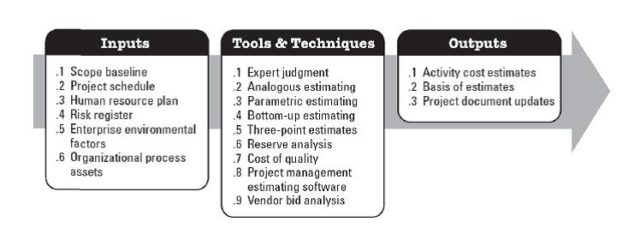Estimate Cost in Project Cost Management
Cost estimating is one of three activities performed in project cost management and one of the most important steps in project management. A cost estimate establishes the base line of the project cost at different stages of development of the project. A cost estimate at a given stage of project development represents a prediction provided by the cost engineer or estimator on the basis of available data. It includes the identification and consideration of costing alternatives to initiate and complete the project.
Cost is estimated for all resources that will be charged to the project. This includes, but is not limited to, labor, material, equipment, service, and facilities, as well as special categories such as inflation allowance or contingency costs. A cost estimate is a quantitative assessment of the likely costs for resources required to complete the activity.
Figure 2. Estimate Costs: Inputs, Tools & Techniques, and Outputs
Source: Project Management Institute (2008, p169), A Guide to the Project Management Body of Knowledge
There are six inputs that are used to estimate costs:
- Scope baseline.
The cost baseline is the basis for the earned value reporting system. It is the budget for the estimated cost of the project spread over the time periods of the project. As we noted in project, in managing a project we are concerned about three baselines: the schedule baseline, the cost baseline, and the scope baseline. These three baselines comprise the goals of any project and deliver to the stakeholders what was asked for, in the time predicted, and for the money that was estimated.
- Project schedule
Projects consume large amounts of cost and knowing when such costs are needed, are important particularly when considering cash-flow. The type and quantity of resources and the amount of time which those resources are applied to complete the work of the project are major factors in determining the project cost.
- Human resource plan.
This document shows what types of resources the project will need and includes how all they will be procured. Both of these aspects will have a direct affect on cost estimates generated in the estimate costs process.
- Risk register.
All risks contain impact. Here, the risk register will help identify the risks that will have an impact on estimate costs, and these will need to be factored in when estimating project costs. The register will also contain opportunities, and any that may reduce costs are important to consider here.
- Enterprise environmental factors
The environment within which the project is to be run will have a large effect on the estimate costs and hence the budget that will be required. The marketplace, policies, procedures and processes, laws and regulations are just some examples of factors that will have a direct affect on costs.
- Organizational process assets
Usually cost information can be gleaned from previous similar projects, lessons learned, or any guidelines that must be followed. In addition there may be software tools or databases that contain important cost data.


